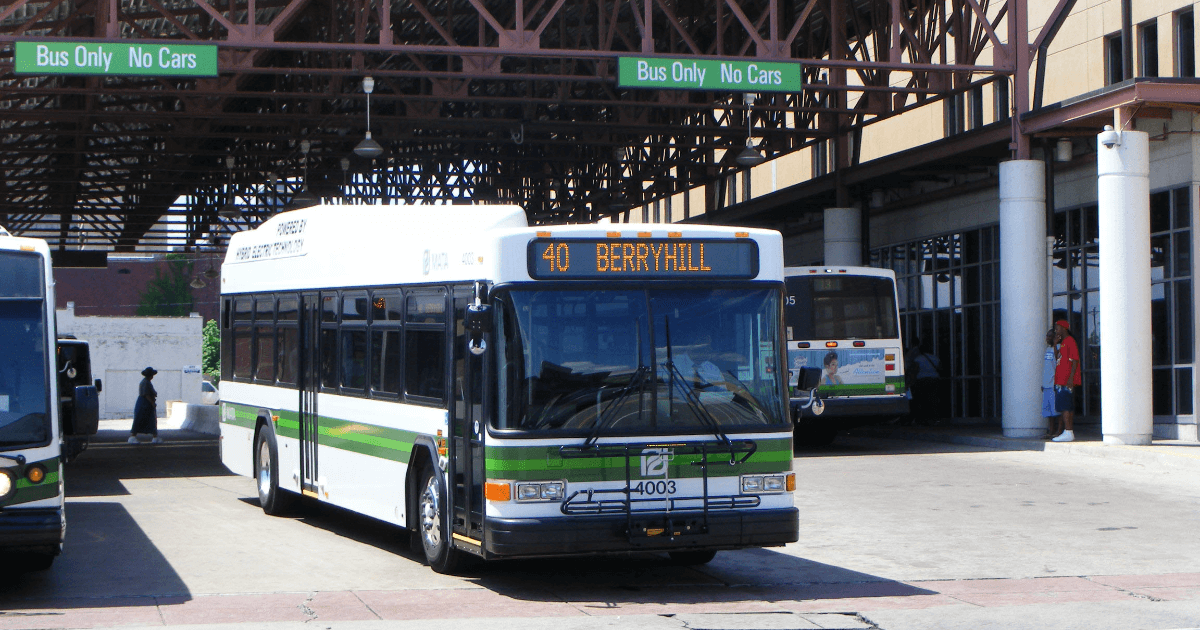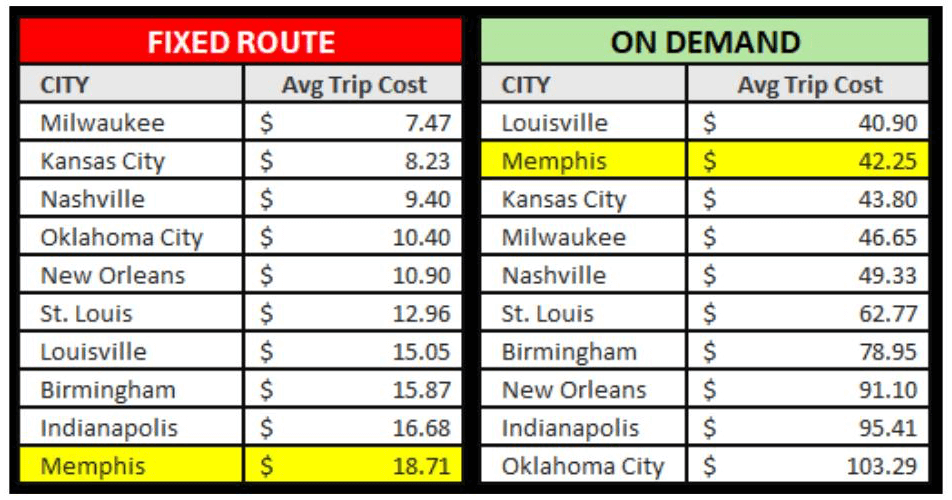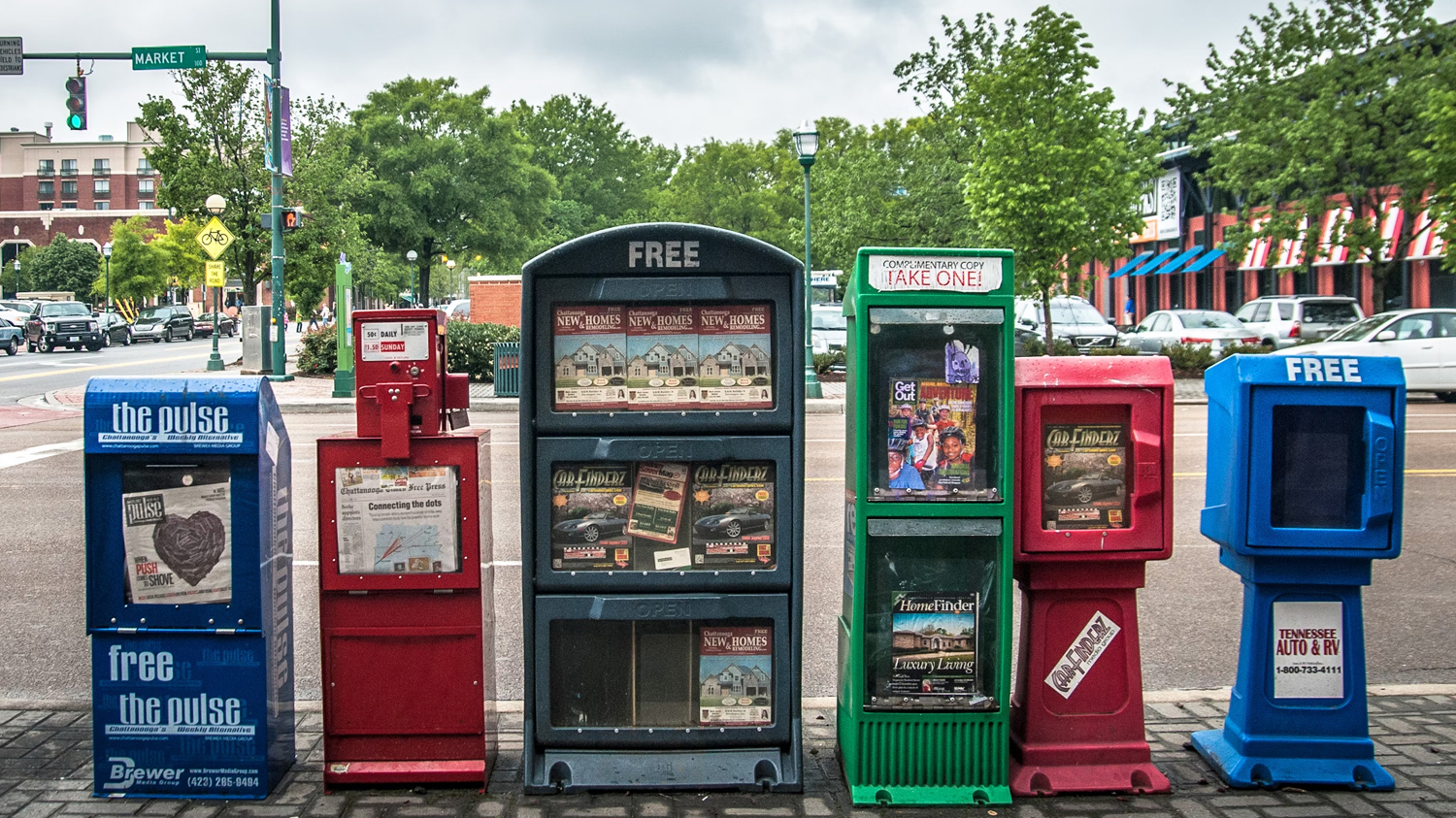

Increased funding for unreliable fixed route MATA transit service makes taxpayers nervous, as do those large empty buses boating throughout the city. The below chart shows declining Memphis fixed route ridership, since 2002, in percentage terms versus the average of ten peer cities. The ten cities are: Birmingham, Indianapolis, Kansas City, Louisville, Memphis, Milwaukee, Nashville, New Orleans, Oklahoma City and St. Louis.

Since 2002, fixed route ridership declined across the peer group, with Memphis declining more than the peer average. The Memphis percentage decline 2002-23, at 77%, exceeds the peer average decline of 41%. And to make matters worse, ridership in Memphis is not recovering after COVID, while it has improved in the overall peer group by fifteen percentage points.
Turns out the 2019 MATA Transit Vision plan has resulted in another public botch. Seems the public is supposed to blame the recently departed MATA CEO Gary Rosenfeld for the botch. But keep in mind, public botching is a mainstay in Memphis. One can look no further than the workforce development system, which has been continually botched over the last 10 yrs., and includes such failed initiatives as GMACW, UpSkill901, Workforce Mid-South and Memphis Shelby County Schools.
One can tell there has been a major transit botch just based on the titles of the public proposals offered by local transit advocate Innovate Memphis. In 2019 Innovate Memphis released a proposal entitled “Memphis 3.0 Transit Vision Recommended Network and 2040 Transit Vision” and now the most recent Innovate Memphis proposal is entitled, “Memphis Public Transit In Crisis”. But there is hope in the new plan offered by Innovate Memphis, with a call for increased, more reliable on demand service.
MATA Reorganization
MATA has recently reorganized after the abrupt departure of Gary Rosenfeld, with new CEO Bacarra Mauldin now cleaning up. At the last MATA Board meeting on February 27, it was announced that there were no available MATA financials available for board review and there would likely not be any financials for the next March board meeting. Not good.
Also reported at the last MATA Board meeting was that MATA was undergoing an every 3 yr. federal triennial audit. Expected audit findings discussed at the last meeting concern deficiencies with MATA procurement and contract management practices.
And finally, also announced at the board meeting was the delay of the $136M Bus Rapid Transit (BRT) project until 2031. BRT features electric buses that do not run in extreme temperatures but offer increased pickup frequency when they are running. The planned BRT fixed route runs from the University of Memphis on Central to Poplar and then on to Union to Downtown. Below is the original timeline, with BRT to be operational at the beginning of 2026, with a notation of the new timeline in yellow.

The doubling of the Memphis BRT construction timeline to 2031 suggests that the expensive $136M BRT project has diverted resources away from offering more reliable MATA transit service in the current day. Besides, Birmingham, AL opened a BRT in October 2022, only to have overall fixed route ridership drop by 3% in calendar year 2023 from 2022. The Brimingham ridership drop came with the benefit of one full BRT service year in 2023, as opposed to only 3 months of service in FY22. Again, not good while suggesting BRT may be over amped.
So, let’s get back to reality with providing service in the current day !
Costs and Case for On Demand Service Increase

An examination of the National Transit Database, based on the most recent FY22 figures available in the above table, reveals a significant ranking disparity between MATA average trip cost for fixed route and on demand service. Regarding fixed route service, Memphis resides at the bottom with the most expensive average trip cost of $18.71, but near the top regarding on demand service, with an average trip cost of $42.25. The disparity in the ranking between fixed route and on demand signals a potential imbalance in the configuration of the MATA transit network.
Further, it would appear based on FY22 numbers that average on demand trip cost could rise from $42, with Memphis still retaining a respectable peer cost ranking. The former is not the case with MATA fixed route average trip cost being the most expensive in the peer group, making MATA fixed route costs unsustainable. MATA fixed route average trip costs must come down, likely through unfortunate fixed route service reductions or eliminations.
On Demand Service Increases on the Table

As part of a comprehensive proposal, Courtney McNeal and Innovate Memphis are proposing a significant increase in on demand service with service increasing from current levels to Airways, American Way, Riverdale, Berclair, Binghampton and Raleigh. Per the last MATA meeting, on time performance for on demand, is around 95% compared to fixed route service at around 57% . Given these numbers, on demand service, while more expensive, could increase on-time performance by as much as 66% from current fixed route performance levels.
Hopefully, along with fare increases for improved service, overly expensive fixed routes can be addressed to help fund expanded, more reliable and smartly expanded on demand services, while investing in improving overall less expensive fixed route performance. The former will need to be considered, as expiring PILOTs will likely only result in 33% or $10M of the $30M recurring revenue projected by 2030. And taxpayers are unlikely to support higher taxes to support public transit unless assured of optimal network configuration and more reliable transit service.
So smartly increasing on demand services seems the way to go in increasing current day services, while confronting out of control fixed route average trip costs. As far as fixed route BRT, not so fast….
MATA Ask
To facilitate an informed community conversation, could MATA design a graphic with the most recent average unlinked passenger trip cost labeled on a map over individual MATA fixed routes? And secondly, the average unlinked passenger trip cost labeled over the on-demand service areas?

Put your business in front of thousands of LOCALS! Create your free listing on the NewsSTAND and update your profile anytime to share the latest info, specials, and contact details.

Got a story to Share? Pitch your idea or write an article for the NewsSTAND! Join us in highlighting the positive and powerful moments that make our city shine.

We’re passionate about working together to amplify our City. Reach out to the NewsSTAND team to explore collaboration opportunities and make a difference in our community.
Hover over each card to unlock the full story and see what you’re about to get!







